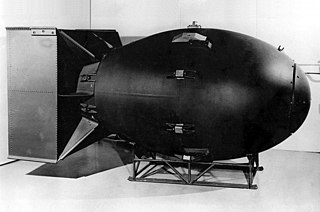
"Fat Man" was the codename for the type of nuclear weapon the United States detonated over the Japanese city of Nagasaki on 9 August 1945. It was the second and largest of the only two nuclear weapons ever used in warfare, the first being Little Boy, and its detonation marked the third nuclear explosion in history. The first one was built by scientists and engineers at Los Alamos Laboratory using plutonium manufactured at the Hanford Site and was dropped from the Boeing B-29 Superfortress Bockscar piloted by Major Charles Sweeney.
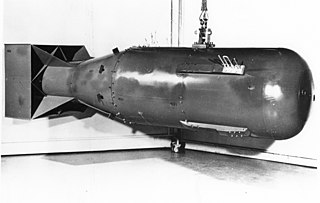
Little Boy is the name of the type of atomic bomb used in the bombing of the Japanese city of Hiroshima on 6 August 1945 during World War II, making it the first nuclear weapon used in warfare. The bomb was dropped from the Boeing B-29 Superfortress Enola Gay piloted by Colonel Paul W. Tibbets Jr., commander of the 509th Composite Group, and Captain Robert A. Lewis. It exploded with an energy of approximately 15 kilotons of TNT (63 TJ) and had an explosion radius of approximately 1.3 kilometers which caused widespread death across the city. The Hiroshima bombing was the second nuclear explosion in history, after the Trinity nuclear test.

The Manhattan Project was a research and development program undertaken during World War II to produce the first nuclear weapons. It was led by the United States in collaboration with the United Kingdom and Canada. From 1942 to 1946, the project was directed by Major General Leslie Groves of the U.S. Army Corps of Engineers. Nuclear physicist J. Robert Oppenheimer was the director of the Los Alamos Laboratory that designed the bombs. The Army program was designated the Manhattan District, as its first headquarters were in Manhattan; the name gradually superseded the official codename, Development of Substitute Materials, for the entire project. The project absorbed its earlier British counterpart, Tube Alloys, and subsumed the program from the American civilian Office of Scientific Research and Development. The Manhattan Project employed nearly 130,000 people at its peak and cost nearly US$2 billion, over 80 percent of which was for building and operating the plants that produced the fissile material. Research and production took place at more than 30 sites across the US, the UK, and Canada.

Ernest Orlando Lawrence was an American nuclear physicist and laureate of the Nobel Prize in Physics in 1939 for his invention of the cyclotron. He is known for his work on uranium-isotope separation for the Manhattan Project, as well as for founding the Lawrence Berkeley National Laboratory and the Lawrence Livermore National Laboratory.

Trinity was the code name of the first detonation of a nuclear weapon, conducted by the United States Army at 5:29 a.m. MWT on July 16, 1945, as part of the Manhattan Project. The test was of an implosion-design plutonium bomb, nicknamed "The Gadget", of the same design as the Fat Man bomb later detonated over Nagasaki, Japan, on August 9, 1945. Concerns about whether the complex Fat Man design would work led to a decision to conduct the first nuclear test. The code name "Trinity" was assigned by J. Robert Oppenheimer, the director of the Los Alamos Laboratory, possibly inspired by the poetry of John Donne.
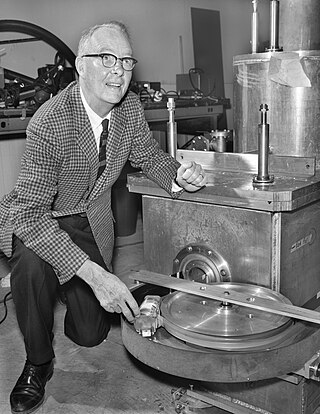
Luis Walter Alvarez was an American experimental physicist, inventor, and professor who was awarded the Nobel Prize in Physics in 1968 for his discovery of resonance states in particle physics using the hydrogen bubble chamber. In 2007 the American Journal of Physics commented, "Luis Alvarez was one of the most brilliant and productive experimental physicists of the twentieth century."

The National Superconducting Cyclotron Laboratory (NSCL), located on the campus of Michigan State University was a rare isotope research facility in the United States. Established in 1963, the cyclotron laboratory has been succeeded by the Facility for Rare Isotope Beams, a linear accelerator providing beam to the same detector halls.
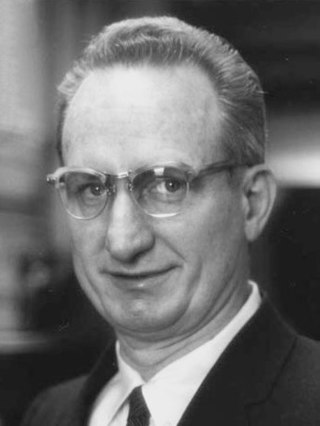
Leo James Rainwater was an American physicist who shared the Nobel Prize in Physics in 1975 for his part in determining the asymmetrical shapes of certain atomic nuclei.
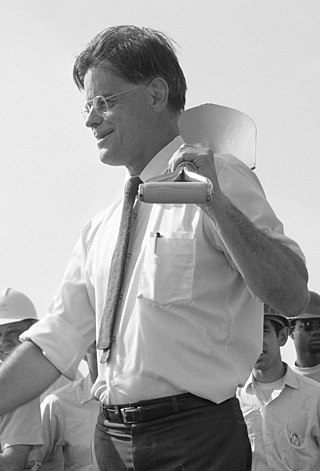
Robert Rathbun Wilson was an American physicist known for his work on the Manhattan Project during World War II, as a sculptor, and as an architect of the Fermi National Accelerator Laboratory (Fermilab), where he was the first director from 1967 to 1978.

Kenneth Tompkins Bainbridge was an American physicist at Harvard University who worked on cyclotron research. His accurate measurements of mass differences between nuclear isotopes allowed him to confirm Albert Einstein's mass–energy equivalence concept. He was the Director of the Manhattan Project's Trinity nuclear test, which took place July 16, 1945. Bainbridge described the Trinity explosion as a "foul and awesome display". He remarked to J. Robert Oppenheimer immediately after the test, "Now we are all sons of bitches." This marked the beginning of his dedication to ending the testing of nuclear weapons and to efforts to maintain civilian control of future developments in that field.

Project Alberta, also known as Project A, was a section of the Manhattan Project which assisted in delivering the first nuclear weapons in the atomic bombing of Hiroshima and Nagasaki during World War II.
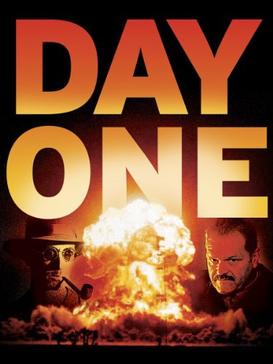
Day One is a made-for-TV docudrama film about The Manhattan Project, the research and development of the atomic bomb during World War II. It is based on the book by Peter Wyden. The film was written by David W. Rintels and directed by Joseph Sargent. It starred Brian Dennehy as General Leslie Groves, David Strathairn as Dr. J. Robert Oppenheimer and Michael Tucker as Dr. Leo Szilard. It premiered in the United States on March 5, 1989 on the CBS network. It won the 1989 Emmy award for Outstanding Drama/Comedy Special. The movie received critical acclaim for its historical accuracy despite being a drama.

Herbert Lawrence Anderson was an American nuclear physicist who was Professor of Physics at the University of Chicago.
Eugene Theodore Booth, Jr. was an American nuclear physicist. He was a member of the historic Columbia University team which made the first demonstration of nuclear fission in the United States. During the Manhattan Project, he worked on gaseous diffusion for isotope separation. He was the director of the design, construction, and operation project for the 385-Mev synchrocyclotron at the Nevis Laboratories, the scientific director of the SCALANT Research Center, and dean of graduate studies at Stevens Institute of Technology. Booth was the scientific director of the SCALANT Research Center, in Italy.

Edward Joseph Lofgren was an American physicist in the early days of nuclear physics and elementary particle research at the Lawrence Berkeley Laboratory (LBL). He was born in Chicago. He was an important figure in the breakthroughs that followed the creation of the Bevatron, of which he was the director for a time.

Harold Melvin Agnew was an American physicist, best known for having flown as a scientific observer on the Hiroshima bombing mission and, later, as the third director of the Los Alamos National Laboratory.
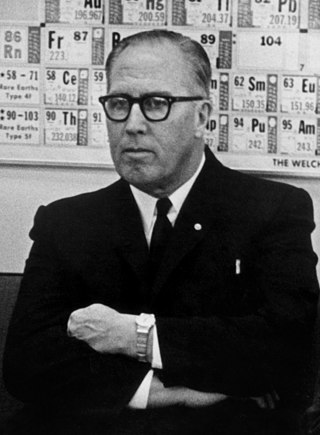
Clarence Edward Larson was an American chemist, nuclear physicist and industrial leader. He was involved in the Manhattan Project, and was later director of Oak Ridge National Laboratory and commissioner of the U.S. Atomic Energy Commission.

George Thomas Reynolds was an American physicist best known for his accomplishments in particle physics, biophysics and environmental science.

Lawrence Harding Johnston was an American physicist, a young contributor to the Manhattan Project. He was the only man to witness all three atomic explosions in 1945: the Trinity nuclear test in New Mexico and the atomic bombings of Hiroshima and Nagasaki in Japan.
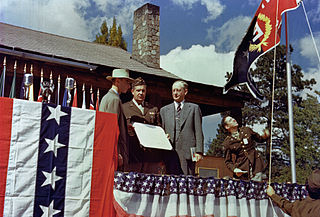
The Los Alamos Laboratory, also known as Project Y, was a secret scientific laboratory established by the Manhattan Project and overseen by the University of California during World War II. It was operated in partnership with the United States Army. Its mission was to design and build the first atomic bombs. Robert Oppenheimer was its first director, serving from 1943 to December 1945, when he was succeeded by Norris Bradbury. In order to enable scientists to freely discuss their work while preserving security, the laboratory was located on the isolated Pajarito Plateau in Northern New Mexico. The wartime laboratory occupied buildings that had once been part of the Los Alamos Ranch School.



















